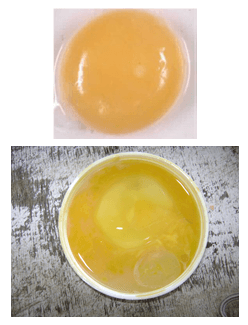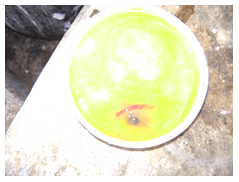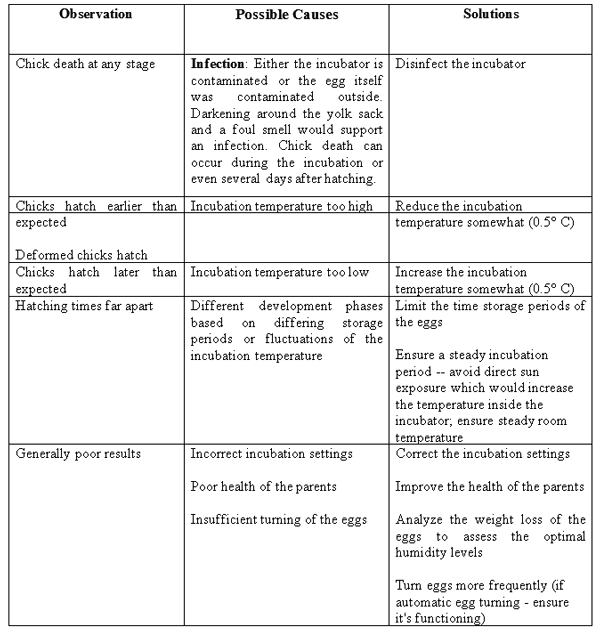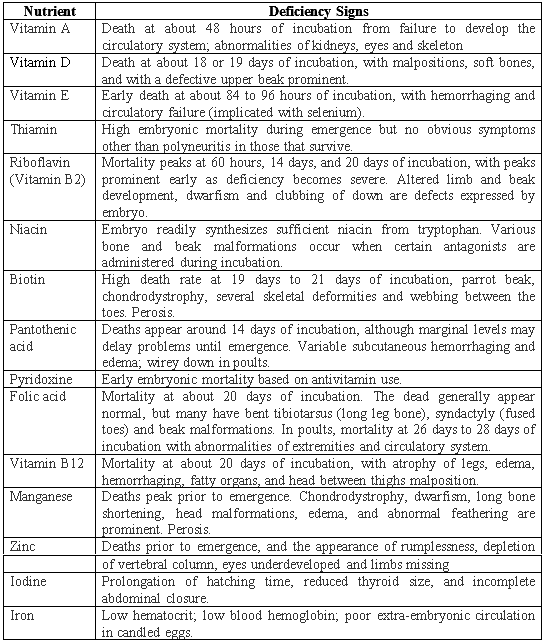Hatch Day Breakout Analysis
Published: April 4, 2019
By: Dr. Suresh F. Nipane / M. V. Sc. (Animal Nutrition), Suman Hatcheries Ltd., Raipur (C.G.).
Introduction
To achieve good hatchability and chick quality, fertile eggs need careful management from the time they are laid. Environmental conditions during egg collection, egg shell disinfection, transport, pre-storage incubation, storage, pre-warming or during incubation are all important. Inappropriate treatment can result in depressed hatchability, change the pattern of embryo mortality and may also affect post-hatching performance. The investigative procedures can be used in the routine quality control programme in the hatchery to benchmark hatchability levels and the nature of embryo losses against accepted best practice standards
Definition:
A hatch breakout analysis involves opening unhatched eggs to determine at what stage of incubation embryo mortality has occurred. A hatch breakout is a useful tool for solving hatch problems and looking for areas to improve hatch performance.
Objectives:
- To quantify the number of embryos dying at different stages of development,
- Look for any indications of abnormal development and other potential causes of hatch loss (e.g. cracks and microbiological contamination).
There are three types of breakout analyses that can be performed on hatching eggs. The first opportunity for a breakout analysis is:
- Fresh hatching eggs.
- Candling eggs at 7 to 12 days of incubation and
- Breakout at hatch time/day
All three methods are fairly simple and each one provides a powerful means of problem solving that can strengthen a hatchery-breeder quality control program.
You may be throwing away valuable information in your hatchery waste that could help solve hatchery and breeder flock problems, or improve hatchability and profitability. Unhatched eggs hold information that breeder and hatchery managers need. Without breaking eggs to gain this information, reasons for moderate to low hatchability are only guesses.
The hatch day breakout analysis involves sampling unhatched eggs from breeder flocks, and classifying them into the various causes of reproductive failure.
The hatch day breakout analysis involves sampling unhatched eggs from breeder flocks, and classifying them into the various causes of reproductive failure.
The hatch day breakout analysis should be performed at least once every two weeks on samples of eggs from all breeder flocks, regardless of hatchability performance or flock age. Even good hatching flocks should be monitored to get a true picture of hatchery and reproductive efficiency. Breakout analysis on all breeder flocks is critical in pinpointing problems in setters and hatchers; comparing breeder companies; evaluating flock or farm management; and compiling flock histories for production, fertility, hatchability and reproductive failure. Breakouts are also beneficial for trouble-shooting problems in production, egg handling and storage. For example, high numbers of early deads may indicate prolonged storage or storage at elevated temperatures, or inadequate egg collection procedures.
Breakout Procedure:
- Immediately after the chicks are pulled, collect a minimum of four trays of eggs per breeder flock from different parts of a single setter.
- Remove all unhatched eggs, including pips, from the hatching tray. Place them in filler flats with the large end up and record the flock number.
- It is best when the breakout is done soon after the hatch rather than a day or two later. This gives a more accurate estimate of live versus dead in shell.
- Record the number of cull and dead chicks left in the tray.
- Break out the eggs and classify them into the appropriate categories as:
- Infertile
- Germ in Shell
- Dead in Shell
- Blasting
- Live
- Pipped (unhatched)
Infertile:
No visible embryonic growth. The dense white area characteristic of the infertile blastodisc may be seen if the eggs are candled and examined early in incubation. It may not be obvious after the full incubation period.

Causes:
- In females mostly due to over-feeding and obesity.
- In males mostly due to over-feeding and under-feeding
- If a hen produces an egg, infertility may be due simply to absence of semen in oviduct.
- Infectious diseases in Broiler Breeder i.e. Viral and Bacterial.
- Sperm concentration, viability & motility is highest at maturity & up to 45 to 50 wks of age which may start declining after 52 to 55 wks
- Depends upon feed & season.
- The seasonal decline in fertility has been attributed to the inability of the hens to store adequate number of sperms in the SST (sperm storage tubules).
- Watery (quality) & contaminated semen.
- If quality of spermatozoa deteriorated.
- Less no. of spermatozoa inseminated(Approximately 100 million sperms per insemination are recommended to obtain optimum fertility).
- Improper technique of insemination.
- More time for insemination in hot (summer) period.
- Improper care of semen in summer during A.I.
- Thermal shock during insemination & condition under which semen is held in vitro.
- Not properly use sterilised equipments for AI.
- Immature males
- Males not mating because they are overweight or have foot problems (Bumble foot).
- Males losing condition due to insufficient feed.
- Mating ratio too high or too low.
- Females avoiding males because they are, or have been, too vigorous (i.e. over mating).
Early Germ in Shell:
There may be no obvious embryo, but the growth of the cream colored extra embryonic membranes should be evident (up to one centimeter diameter by one day of age, up to three centimeters in diameter by two days of incubation) if eggs are candled and broken out early in incubation. There is no blood present.

Causes:
- Most likely to be a farm, transport or storage problem.
- Infrequent egg collection.
- Jarring in handling or transport,
- Eggs not allowed to settle at hatchery before setting,
- Eggs stored too long (i.e. >7 days) or stored in unsuitable conditions (i.e. too cold, too warm or fluctuating temperature).
- Incorrect disinfection of eggs (e.g. washing at too high a temperature or fumigation in the first 12-96 hours of incubation)
- High early incubation temperature.
Dead-in-Shell:
Embryo death predominately occurs at two periods during incubation:
- Within the first 3 days of incubation - early embryo death occurs during formation of embryonic organs.
- Within the last 3 days immediately before a hatch.

Causes:
- NutritionalDeficiency of Embryo:
- Incubation Problem/Failure:
- Bacterial or viral infection (sanitary and dry environment will help to prevent this)
- Contaminated by hands as eggs are handled (turned or candled).
- Poorly maintained incubator - incubators need to be disinfected and cleaned thoroughly before adding eggs.
- Dead or infertile eggs that are spoiling and are left inside the incubator in close proximity with viable eggs.
- Shaking / Vibrations in the early stages will kill any chick inside the egg; at the later stage, it can result in crippled chicks
- Hatchability requires certain humidity and temperature levels: Please follow the instructions of the incubator that you are working with.
- Egg being chilled (interruption of incubation process)
- Dehydration (misting the eggs with warm water may help)
- Death immediately before a hatch occurs during the transition between living in an egg to living on the outside. The chick can have difficulty positioning for pipping, absorbing the yolk sac, or changing to breathing air. Sometimes humidity control can be implicated.
- Hypocalcaemia: Excess calcium causes the eggshell to harden making it difficult to impossible for chicks to hatch. Unless they are assisted, they will die.
Incubation Problems / Failures:
Possible Causes:
1. Considerably incorrect incubator settings either through malfunction or incorrect settings: Hatching temperature and humidity should be different from the incubation temperature and humidity. The change should be made anywhere from a week to three days prior to the expected hatch date (basic incubators need to manually adjusted, while the more sophisticated models can be set to make changes automatically).
2. Humidity: If the humidity is too high the chick could drown inside the air cell. If the chick does survive, the hatching chick looks swollen and too big for the shell - that is indication that the humidity was too high throughout the incubation period, and the chick did not lose enough weight during incubation. Even if the humidity was too high during incubation, the chick will still need maximum humidity for hatching.
- If the humidity is to dry, the chicks get "shrink-wrapped" by the membrane, which dries out and turns sticky - preventing the chicks from rotating in the shell. If the humidity is too low during any part of the incubation period, this can result in chick death at any stage of its development.
3. Temperature: One temperature spike is unlikely to kill a developing chick. It takes more than a few minutes at a higher temperature than normal before a chick is killed. If you had other eggs in the incubator that hatched with the egg that didn't, this problem can probably be ruled out (although some basic incubators may have "hot spots" or "cool spots" -- depending on air circulation inside the incubator.
- If the chick hatches very early - that is indication that the temperature was too high during incubation. If the chick is hatching too late, that is a sign that the temperature was too low or the egg got chilled during incubation.
4. Egg Turning: During the incubation period, eggs need to be turned several times a day. However, the last 3 days before hatching, the chick is fully formed and, at this stage, is in the process of absorbing egg yolk into the abdomen (for nutrition). If the handler continues to turn the egg at this stage, the yolk sac can become twisted potentially preventing absorption of the yolk and starvation or at least weakening of the chick. Also, breaking out will be more difficult if the yolk contents have not been absorbed.
- If the egg has been turned like all the other eggs, then turning can also be ruled out.
5. Calcium Surplus: Too much calcium in the mother hen's diet can result in thick-shelled egg shells, which will prevent chicks from hatching. Generally one can tell if there is too much calcium, if the egg shell isn't smooth. One can see irregular bumps on the surface.
6. Over handling of the eggs: Skin oils prevent oxygen from getting into the egg resulting in suffocation of the chick, as the oil blocks the pores. One way to tell if this is the problem is if the surface of the eggs looks glossy.
7. Lethal Gene: Some breeds carry "lethal" genes, particularly if related birds are bred.
Solutions:
- Candle the eggs to assess fertility and condition
- Verify the settings of the incubator - particularly the temperature
- Reduce the humidity inside the incubator somewhat

Pipped Air Cells:
The embryo fills the shell, and the beak has penetrated the air cell in the blunt end of the shell. The yolk sac is mostly or entirely inside the abdomen. Developmental abnormalities may be visible.
Causes:
- Same as for an excess of “turned” embryos,
- Also possibility of humidity being too high after transfer.
Pipped Shells:
Fully formed embryo has made a hole in the shell, but has not emerged. It may be alive or dead at the time of opening.

Causes:
- Low humidity, high temperatures or inadequate ventilation in the hatcher.
- Inadequate turning or eggs set upside down.
- Nutritional deficiencies
- Disease can also increase mortality at this stage
- As can excessive egg storage time
- Transfer damage or excessive fumigation during hatching.
Blasting:
During incubation of hatching eggs, multiplication of aerobic bacteria and producing different types of gages inside the eggs resulting in death of developing embryos or sometimes burst the eggs in setter due to infection.
Causes:
- Setting of dirty eggs
- Improper egg washing
- Dust
- Water condensation
- Contact of fecal material on egg shell from long time.
- Improper egg dipping
- Infectious diseases like Bacterial and Viral through parent
- Unhygienic condition of setter
- Once blast in setter, it increases the number of blasting eggs through spreading infection to others eggs.

Rotten eggs:
One rotten egg which explodes in the setter or hatcher has the capacity to contaminate many other eggs or chicks, trays, tray carriers, trollies, fans.
Green rots: Pseudomonas
White rots: Corynebacterium
Black rots: Aspergillus
Effects of Nutrition on Infertility, Embryo Mortality and Hatchability:
Depending on the degree of malnutrition, either death or physical symptoms will occur.

Related topics:
Authors:
Suman Hatchery Ltd.
Influencers who recommended :
Sachin PatilRecommend
Comment
Share
Recommend
Reply

Would you like to discuss another topic? Create a new post to engage with experts in the community.









.jpg&w=3840&q=75)